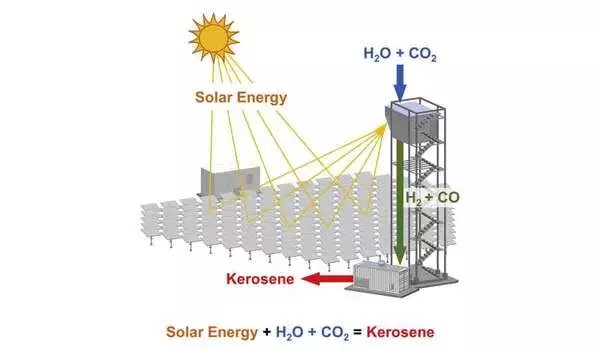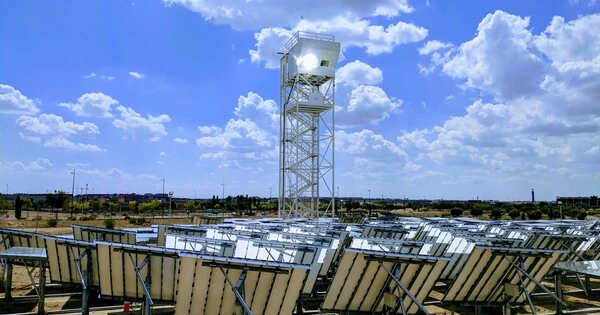Solar fuels are fuels created from common substances such as water and carbon dioxide by harnessing the energy of the sun. Sunlight striking the earth contains enormous energy, but it is time-varying and dispersed, making it difficult to harness sunlight for practical use. We have successfully harnessed solar energy to generate electricity, but we have yet to efficiently convert it to liquid fuels. Solar fuels could provide a plentiful supply of renewable, storable, and portable energy.
Researchers have created an aviation fuel production system that uses water, carbon dioxide (CO2), and sunlight. They have put the system into action, and the design, which was published in the journal Joule, could help the aviation industry become carbon neutral.
“We are the first to show the entire thermochemical process chain from water and CO2 to kerosene in a fully integrated solar tower system,” says Aldo Steinfeld (@solarfuels), an ETH Zurich professor and the paper’s corresponding author. Previous attempts to produce aviation fuels using solar energy have mostly been carried out in the laboratory.
With our solar technology, we have shown that we can produce synthetic kerosene from water and CO2 instead of deriving it from fossil fuels. The amount of CO2 emitted during kerosene combustion in a jet engine equals that consumed during its production in the solar plant.
Aldo Steinfeld
The aviation industry is responsible for approximately 5% of global anthropogenic emissions that cause climate change. It is heavily reliant on kerosene, also known as jet fuel, which is a liquid hydrocarbon fuel derived primarily from crude oil. At the moment, there are no clean alternatives available to power long-haul commercial flights on a global scale.
“With our solar technology, we have shown that we can produce synthetic kerosene from water and CO2 instead of deriving it from fossil fuels. The amount of CO2 emitted during kerosene combustion in a jet engine equals that consumed during its production in the solar plant,” Steinfeld says. “That makes the fuel carbon neutral, especially if we use CO2 captured directly from the air as an ingredient, hopefully in the not-too-distant future.”
As a part of the European Union’s SUN-to-LIQUID project, Steinfeld and his colleagues have developed a system that uses solar energy to produce drop-in fuels, which are synthetic alternatives to fossil-derived fuels such as kerosene and diesel. The solar-made kerosene is fully compatible with the existing aviation infrastructure for fuel storage, distribution, and end use in jet engines, Steinfeld says. It can also be blended with fossil-derived kerosene, he adds.

In 2017, the team began scaling up the design and construction a solar fuel manufacturing plant at the IMDEA Energy Institute in Spain. The plant is made up of 169 sun-tracking reflective panels that redirect and concentrate solar radiation into a tower-mounted solar reactor. The concentrated solar energy then powers oxidation-reduction (redox) reaction cycles in the solar reactor’s porous ceria structure. The ceria, which is not consumed but can be reused, converts the water and CO2 injected into the reactor into syngas, a customized mixture of hydrogen and carbon monoxide. Syngas is then fed into a gas-to-liquid converter, where it is converted into liquid hydrocarbon fuels such as kerosene and diesel.
“This solar tower fuel plant was operated with a setup relevant to industrial implementation, setting a technological milestone towards the production of sustainable aviation fuels,” Steinfeld says.
The solar reactor’s energy efficiency (the portion of solar energy input that is converted into the energy content of the syngas produced) was around 4% during a nine-day run of the plant reported in the paper. Steinfeld claims that his team is working hard to improve the design in order to increase efficiency to values greater than 15%. For example, they are investigating ways to optimize the ceria structure for solar radiation absorption and developing methods to recover heat released during redox cycles. The Swiss State Secretariat for Education, Research, and Innovation, as well as the EU Horizon 2020 research and innovation program, are supporting this work.
Solar fuels would diversify our fuel supply while also increasing the overall sustainability of our energy system. They would also make extensive use of existing fuel infrastructure for a wide range of applications. These fuels could be kept for several hours, days, months, or even years. Solar fuels are portable, making them a valuable and adaptable resource for a more reliable electric power grid.
“Artificial photosynthesis” is one method for producing solar fuels. This method would generate fuel using only water, carbon dioxide, and sunlight, much like natural photosynthesis in plants.





